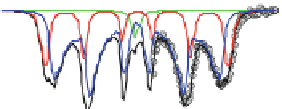Chemistry Reference
In-Depth Information
-8
-4
0
4
8
-8
-4
0
4
8
1,00
1,00
0,99
0,99
0,98
30
40
0,98
0,97
1,00
-8
-4
0
4
8
1,00
0,98
37.5
0,96
27.5
0,99
0,94
1,00
-8
-6
-4
-2
0
2
4
6
8
1,00
0,99
0,99
35
25
0,98
1,00
1,00
-8
-6
-4
-2
0
2
4
6
8
0,98
0,96
22.5
32.5
0,99
0,94
-8
-4
0
4
8
-8
-4
0
4
8
V (mm/s)
V (mm/s)
Fig. 4.30
300 K Mössbauer spectra of the MA Fe100-xNix samples milled for 10 h [
178
]
the relative orientation of the grains. One concludes that a long-range Coulombic
fall off of the interatomic potentials is necessary to obtain GB structures presenting
a correct local topology but with a smooth transition from crystalline to amorphous
states. Indeed, the crystalline grain result from a cubic packing of corner-sharing
octahedral units while the grain boundaries consist of corner-sharing octahedral
FeF
6
units randomly packed: consequently, the corresponding magnetic structures
behave as antiferromagnet and speromagnet, respectively, in agreement with
experimental features [
169
].
The study of nanostructured ferric fluoride powder provides an excellent
description of such 3D nanostructures, giving evidence for the important role of
grain boundaries and confirms that ferric fluoride appears as an excellent funda-
mental system to correlate magnetic structure and cationic topology through
frustration effects.
High energy ball milling is a route frequently applied to prepare nanoalloys and
nanostructured metallic powders (only some selected examples in [
170
-
177
] but a
lot of studies were reported for the last 25 years). Mössbauer spectrometry con-
tributes in following the alloying process and the characterization of both structural
and magnetic properties. But such an approach requires the improvement of the
fitting model which does take into account the local atomic disorder, the presence of
grain boundaries and the magnetic coupling between nancrystalline grains. An recent
example has been developed to describe the Mössbauer spectra of Fe
100-x
Ni
x





































































































































